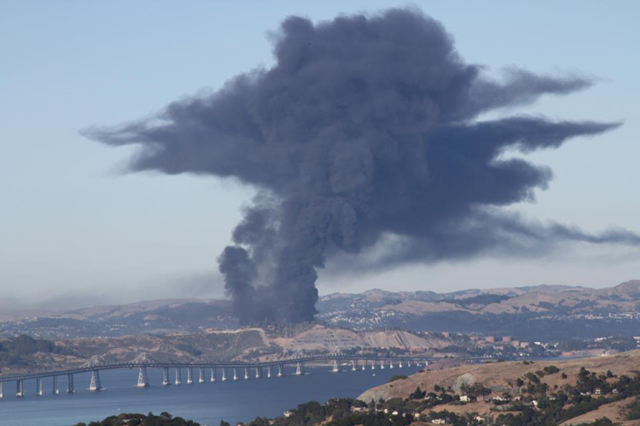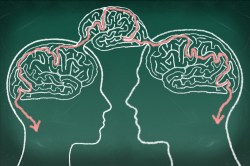Last week, I wrote a post about a familiar dynamic in climate communication: Whenever there’s an episode of extreme weather, one set of people works vigorously to tie it to climate change, while another set of people sets about scolding the first set for exaggerating or misleading.
The post elicited lots of interesting responses — check out the (mostly critical) journalist Curtis Brainard and the (mostly supportive) blog The Way Things Break — but looking back on the discussion now, I didn’t state the main point as clearly as I might have liked. So with your indulgence, I’m going to have another go at it.
Let’s step back from the internecine disputes and look at the big picture. As I see it, there are two moral obligations facing those who communicate about climate change: first, to convey the facts about climate change accurately, and second, to insure that their audiences understand and care about those facts.
These obligations have some overlap, but are not the same. Indeed, they can sometimes come into considerable tension. Everyone who has ever spoken or written about climate change knows the unique difficulties of satisfying both obligations at once. Most attempts fail at one or the other. What bothers me about the scolds is that they often seem to dismiss or ignore the second obligation.
I believe that both obligations are real — neither automatically trumps the other — and both deserve consideration. To get our heads around how this works, let’s consider a metaphor.
——
Tom is a physician. He has recently diagnosed a patient of his, Jane, with a degenerative disease that could eventually prove fatal to her. She faces a future of progressively more coughing fits and difficulty breathing, more fevers and aches, more indigestion and vomiting, and eventually total systems breakdown. It’s a grim prognosis.
Here’s the rub: Jane doesn’t feel sick. At the moment, her health seems mostly normal. There have been a few worrisome signs and episodes, but nothing beyond the bounds of her past experience. Tom has explained the science of her disease until he is blue in the face. To her, though, it just sounds … fantastical. Implausible. Some part of her suspects that Tom is lying or exaggerating just to get money out of her. At any rate, she isn’t taking the disease seriously and most of the people in her life aren’t taking it seriously either.
Beating the disease will involve a daunting and expensive course of treatment. Tom knows that every day Jane delays getting started, her risks grow. If she delays long enough, the disease could progress to the point that it’s beyond treatment. He’s not quite sure when that line will be crossed, but it’s likely that Jane won’t suffer the worst of the disease until that line is well past. By the time it feels like a degenerative disease to her, it will probably be too late.
One day, Jane has a terrible bout of the flu — fever, puking, the whole deal. It’s not totally unlike flus she’s had before, but it is unusually sudden and intense. Tom runs some tests. Based on the best epidemiological science, he determines that, while her disease didn’t cause the flu, it increased the intensity of the flu. It made the flu worse — and will make future flus worse yet.
So: What should Tom tell Jane? As her doctor, what is his duty in this situation?
After giving it some thought, he tells her: “What you’re feeling right now? This is your disease. This is your future. Episodes like this are only going to get worse. If you don’t undertake treatment right now, you can expect even more intense flus, alongside nausea, dehydration, and shortness of breath.”
When Tom discusses the case with another doctor in his practice, Helen, she objects to his characterization: “No, this isn’t Jane’s disease. Her flu was caused by infectious agents and poor hand-washing practices. Her disease’s influence on this episode was marginal at best. Stop being so alarmist!”
——
So who’s right, Tom or Helen?
On one hand, Helen seems to have a point. A physician has an obligation to give patients accurate information. Telling Jane that her flu was caused by her disease is deceptive.
On the other hand, Tom didn’t exactly tell her that, did he? “This is your disease” need not be interpreted as a claim about causation, or degrees of attribution. It is a metaphor, meant to create an affective association between the experience of suffering and a disease that promises more of it. It is meant to give Jane a tangible, phenomenological sense of what her disease means.
From his perspective, Tom didn’t mislead Jane about the cause of her flu. He decided that the exact degree to which her flu is attributable to her disease (10 percent? 20 percent?) is not the most important thing for Jane to grasp in the situation. The most important thing for Jane to grasp is the urgency and severity of her disease. So that is what he emphasized. After all, if Jane is hit with a torrent of precise but complicated scientific information and it doesn’t penetrate, doesn’t make any impression, is she really better off?
What’s evident here is the tension between Tom’s obligation to give Jane accurate information and his obligation to help her grasp the gravity of her disease. Obviously we would condemn Tom if he knowingly said something false to Jane. But perhaps not as obviously, we would condemn him if he said true things to her as she frittered away her last chance of saving her own life. Part of his role as her doctor is to help her appreciate the information, so that she understands her situation and her treatment alternatives.
——
In this analogy — in case I didn’t beat you over the head with it enough — Jane is the U.S. public, the disease is climate change, the bout of flu is super-storm Sandy, and the doctor is … well, who?
The world is full of people — journalists, wonks, scientists — who are quick to scold dirty hippies when, in their zeal to satisfy obligation No. 2, they fall short of satisfying obligation No. 1.
But it seems to me that many of those same people satisfy obligation No. 1 but give almost no thought to obligation No. 2. Why don’t we scold them? Why isn’t being boring or opaque or disinterested a sin worth of censure?
Some folks might want to say: “Journalists and wonks and scientists are not like doctors. Their only obligation is to convey accurate information. It’s someone else’s job to make people care.” In my mind, that simply isn’t a defensible position. Humanity is at stake. Clinical disinterest in that matter cannot conceivably be cast as a virtue.
Recently New York Times Dot Earth blogger Andy Revkin said this:
In the end, there’s sufficient nuance in the science that a disaster [like Sandy] can, like a Rorschach inkblot, be what anyone with a predisposition on global warming wants it to be.
True. The facts and science of the disaster underdetermine what sociocultural meaning it takes on. But that does not mean that Andy Revkin, or you, or I, or anyone, should be neutral about which meaning it takes on. Because it will take on a meaning. And if Andy Revkin doesn’t take a hand in shaping that meaning — if you don’t, if I don’t, if those who understand climate change don’t — someone else will.
We should not be neutral in this matter: We should prefer the meaning that conveys the gravity of climate change. All those involved in communicating climate should take a hand in claiming the storm for that narrative. It is, ultimately, immoral not to.
That is an active role, a participant’s role, rather than an observer’s role. And I know lots of folks in the science, wonk, and journalistic communities are uncomfortable with that. But honestly I think people just need to get over it. Humanity is at stake. All of us are players in this drama. We always have been. To pretend otherwise is no virtue.
——
To sum up: Scientific accuracy is a virtue. But affective impact and moral resonance are also virtues. We cannot say things we know are false about climate change, but we also cannot, in good conscience, be indifferent to whether our words have any effect. Both moral obligations have a claim on us and, contra the scolds, narrow scientific accuracy is not a trump card in every tough case.
Making an impression may well involve loosening language, incorporating allusion and suggestion and polemic and narrative and poetry, which is an uncomfortable prospect for those who have traditionally seen themselves as conveyors of cold facts and facts alone.
But there has never been a problem like climate change. In communication, as in so many other areas, we’re going to have to rethink the old ways of doing things.




